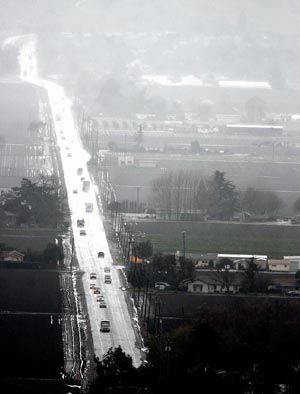In this opinion piece, Marty Richman describes how Caltrans’
description of the Highway 156 improvement project that emerged
from Thursday’s joint meeting of the San Benito County Council of
Governments was disappointing. He says it was like a communication
exercise where people keep passing verbal descriptions of a picture
and the result looks nothing like the original when it comes out in
the end.
Caltrans’ description of the Highway 156 improvement project that emerged from Thursday’s joint meeting of the San Benito County Council of Governments was disappointing. It was like a communication exercise where people keep passing verbal descriptions of a picture and the result looks nothing like the original when it comes out in the end.
Somewhere between our input – “We need to improve the traffic flow on Rte 156 between Hollister and Hwy 101” and the Caltrans output – “Here is what it will look like” – we lost the thread of what we were trying to accomplish.
Who’s been watching the store? The combined political and management capability of San Benito County failed to communicate all we required; now Caltrans is at the 30 percent design review and their bureaucratic concrete is hardening at a rapid rate. Local politicians are getting a taste of their own medicine – this is how citizens feel when government gets the bit in its teeth, determined to feed the beast with illogical decisions, no matter what. The EIR was over 420 pages. It is now closed as we were repeatedly told. However, my gloat is not worth the damage this bad design will do, so I will move on (but I will file the thought for future use).
Below is the premiere of Richman’s Web show, The News and You.
We must improve Highway 156. Efficient transportation arteries are a vital element in economic development and sustainability. A new alternate route is not a good answer economically – nor is it do-able in an acceptable timeframe. We need to fix the current project.
But the improvements cannot occur in a vacuum. In addition to the primary objective, a good design also must meet several key secondary objectives. It cannot increase flooding in the county or make things worse at The Alameda crossing. It should make things better. It must provide the ability to cross safely and it should be as ecologically and aesthetically acceptable as possible. The design presented does not fulfill any of those secondary needs. It is as if “Plan XYZ” were pulled from the files and force-fitted to the project map.
The flood studies are not complete, but it looks as if the raised road is going to act like the sides of a swimming pool. There must be adequate through-flow to allow the water to escape; merely handling roadway runoff is insufficient. Caltrans cannot solve the valley’s flood problems. We just do not want them made worse.
Starting the project on the east side of The Alameda crossing is not going to fix that serious problem and has the potential to it worsen it, certainly in the safety arena. If there were an imaginative way to get rid of the grade crossing and stoplight, most of the noise, pollution and safety issues would go away. The result would be a better road and a happier community. It should be part of the project.
For the full column, get a copy of Tuesday’s Free Lance. Marty Richman is a Hollister resident. His column runs Tuesdays and his Web show, The News and You, premieres every other Tuesday at www.freelancenews.com.










